20th Century

Post-Medieval (1899 -1540)
The area surrounding Chilmington remained rural into the post-medieval period, comprising a combination of farmland and woodland. Records suggest that, by the end of the 17th century, the hamlet was owned by the Toke family of Godinton House (situated to the northwest of Ashford), who leased it out to tenants.
By the 18th century, Chilmington Hamlet included Netters Farmhouse, Chilmington Farmhouse, Great Chilmington Farmhouse and Chilmington Cottage, all of which are Listed (protected) due to their historical importance. By the mid-19th century, occupants of the area are recorded as farming cereals and hops, while pasture for livestock is also noted. Industrial features included a lime kiln and a stone quarry.
Image below – Godinton House, home to the Toke family, the former owners of Chilmington Green.
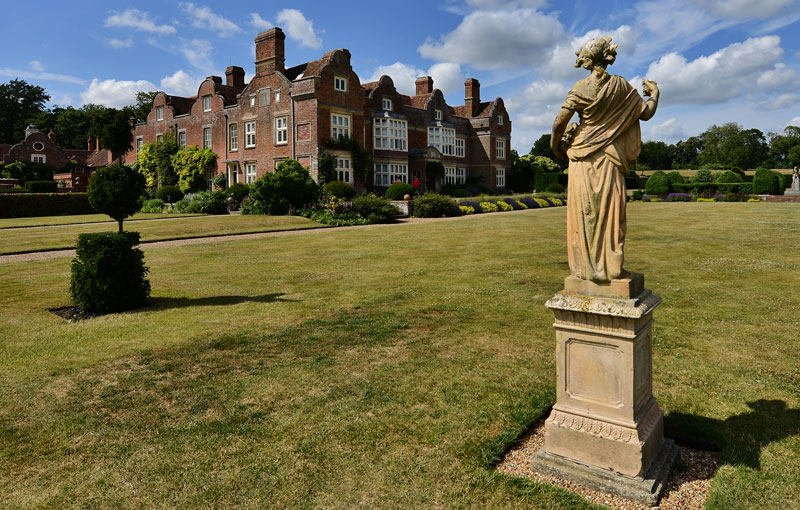
Medieval (AD 1540 – 1066)
The Norman Conquest of England in 1066 marked the beginning of the medieval period. Shortly afterwards, in 1086, the newly crowned King, William the Conqueror, undertook a survey of his newly acquired lands known as Domesday. This document suggests that the nearest village to Chilmington was Great Chart, which is recorded as the property of the Archbishop of Canterbury. Domesday indicates that Great Chart was a large, well-developed settlement by this time, with ploughlands, meadow, woodland, watermills, and a salt house present. This strongly suggests an earlier Saxon origin for the village, even if archaeological evidence for this has been hard to find so far. The first reference to Chilmington itself dates to 1226, when it was recorded as ‘Chelminton’. This again suggests Anglo-Saxon roots for this hamlet or farm, as this placename is thought to derive from the Anglo-Saxon personal name ‘Ceolhelm’, perhaps meaning ‘Ceolhelm’s farmstead’. Archaeological and written sources suggest that the area around Chilmington was largely rural throughout the medieval period, although some evidence of industry in the form of metal working has been discovered.
There are a number of historic buildings in and around Chilmington Hamlet, such as Netters Farmhouse and Great Chilmington Farmhouse, that may date back to the medieval period. Several nearby buildings with medieval origins are also moated. For example, a former moated manorial house was situated at Great Chart, known today simply as ‘The Moat’. Although the original manor house is gone, its nearly square moat is well preserved and still holds water. Another beautiful and historic building in the area is the Church of St Mary at Great Chart, which was in existence by at least the 12th century.
Image below – Scene 39 from the Bayeux Tapestry, showing the arrival of the Norman army on the south coast of England.

Anglo Saxon (AD 1066 – 410)
After, or towards the end of Roman rule in Britain, Germanic peoples known as Angles, Saxons and Jutes began to settle the area that would later become southern and eastern England. This was an important event in the history of Britain: for example, the name of ‘England’ itself derives from the name of the ‘Angle’ tribe, while the Germanic language that we speak today owes much to this event. Despite this, archaeological discoveries relating to the Early to Middle Saxon period are relatively rare compared with what came before and after. This may be because of a population decrease, for example driven by disease or famine, or because the fall of the Roman Empire brought with it economic and supply problems that meant that goods could no longer be consumed in large quantities (making sites of this period harder to identify archaeologically). It is therefore not surprising that there is little evidence for Anglo-Saxon activity around Chilmington Green, although there are clues that suggest that the area was not abandoned altogether. For example, later medieval ditches identified at Westhawk Farm and Brisley Farm followed the alignment of earlier Roman ditches, which could suggest some kind of continuity between these periods. Our research team will investigate this possibility further in our ‘Fields of the Stour Valley’ project. A handful of Anglo-Saxon artefacts have also been collected from the area that include a copper alloy belt fitting and at least three coins, known as sceattas.
.
Image below -Artists reconstruction of an Anglo-Saxon house.
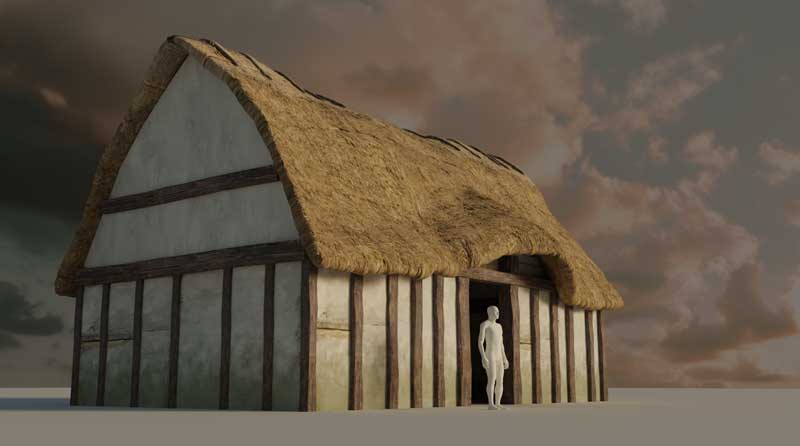
Roman (AD 410 – 43)
What is now Kent had strong connections with the Roman World by at least the time of Julius Caesar’s campaigns against the Britains of 55 and 54 BC, but the area was not fully conquered by Rome until the army of Emperor Claudius landed at Richborough in AD 43. The Roman Conquest brought with it a new political landscape and yet more technological and social change. Large towns emerged, including on the sites of former oppida, as at Colchester, and new towns developed, such as London. Many rural settlements remained modest, however grand villa residences were also constructed, a famous example being Lullingstone near Eynesford in Kent.
A great deal of Roman activity took place at Chilmington Green, which included the development of a roadside settlement and shrine at Westhawk Farm. At Brisley Farm, a second shrine complex developed around the earlier warrior burials. At least three Roman roads may have passed through Chilmington, including the Canterbury and Dover roads.
Image below – Artists impression of Lullingstone Villa (C) Historic England.
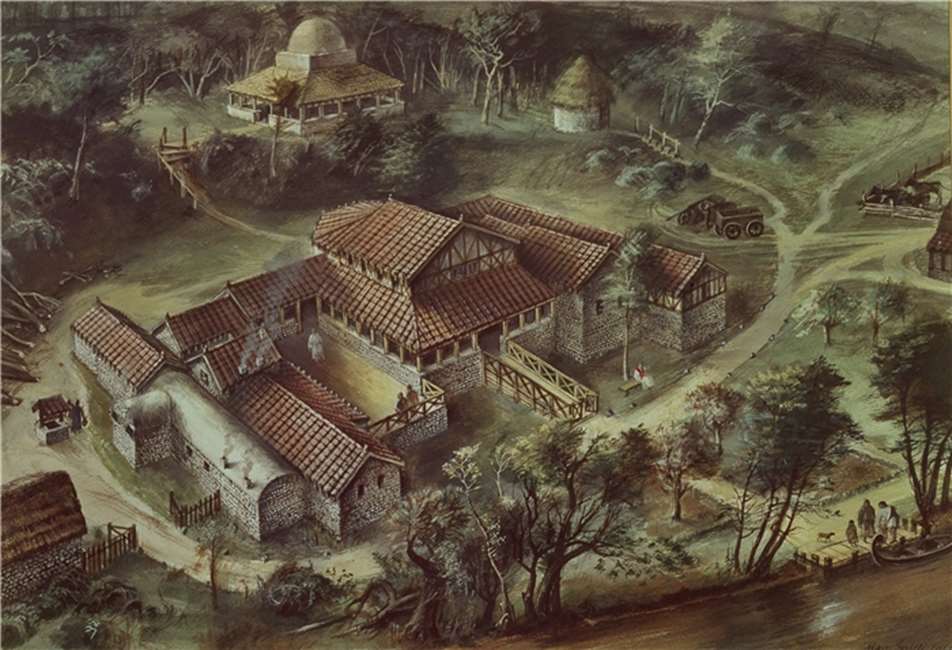
Iron Age (AD 43 – 800 BC)
The movement of people and the introduction of iron working techniques from the Continent around 800 BC marked the beginning of the Iron Age in Britain. The development of iron tools increased agricultural production and population growth. This was accompanied by social changes that included the emergence of an even greater hierarchy of sites that ranged from small farms at one end of the spectrum, through to hillforts and, by the Late Iron Age period, large town-like settlements known as oppida at the other. By the Late Iron Age, the site was situated within the tribal territory of the Cantiaci, from which modern-day Kent gets its name.
There is a great deal of evidence for Iron Age farming and settlement in the vicinity of Chilmington Green, including cremation and inhumation burials. The most significant of these are two 1st century AD ‘warrior burials’, discovered during excavations at Brisley Farm. The ‘warriors’ were buried with grave goods that included swords, spears and beakers. These remarkable burials are an exceptionally rare discovery and are of international importance. Their burial location, overlooking the floodplain of the River Stour, may have been chosen because such watery places were important to the world view of Late Iron Age people in Britain (see Ritual and Religion in the Stour Valley to find out more about this).
Image below – During the Iron Age, people continued to live in dwellings known as round houses, which would have resembled this modern reconstruction.
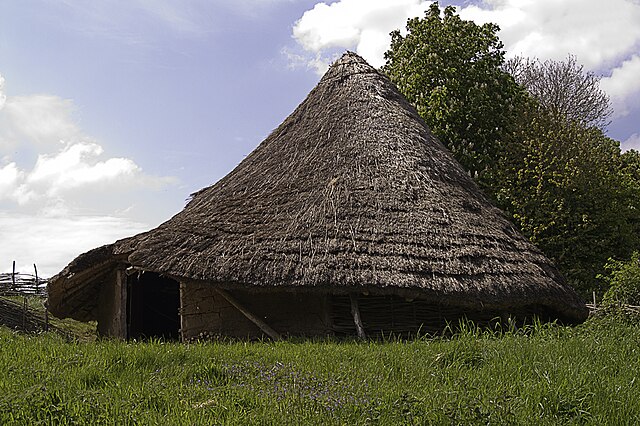
Bronze Age (800 BC – 2600 BC)
The Bronze Age began around 2600 BC when new technologies, beliefs and practices were introduced through the migration of people and ideas from the Continent. This included copper, bronze and gold working, and the production of the first metal tools. This period saw the growth of more permanent settlements, characterised by circular dwellings known as round houses. Forest clearances accelerated to make way for more intensive farming. Fields and settlements with boundaries defined by ditches also began to be created for the first time in this part of Britain, which suggests that people were dividing and assigning ownership to the land in more formalised ways. There is also more evidence to suggest that wealth within communities was divided in an increasingly uneven fashion, suggesting the gradual emergence of social elites. The area around Chilmington Green is packed with evidence for Bronze Age activity, with settlements, field boundaries, and a cremation burial having been discovered.
Image below – A Bronze Age axe.
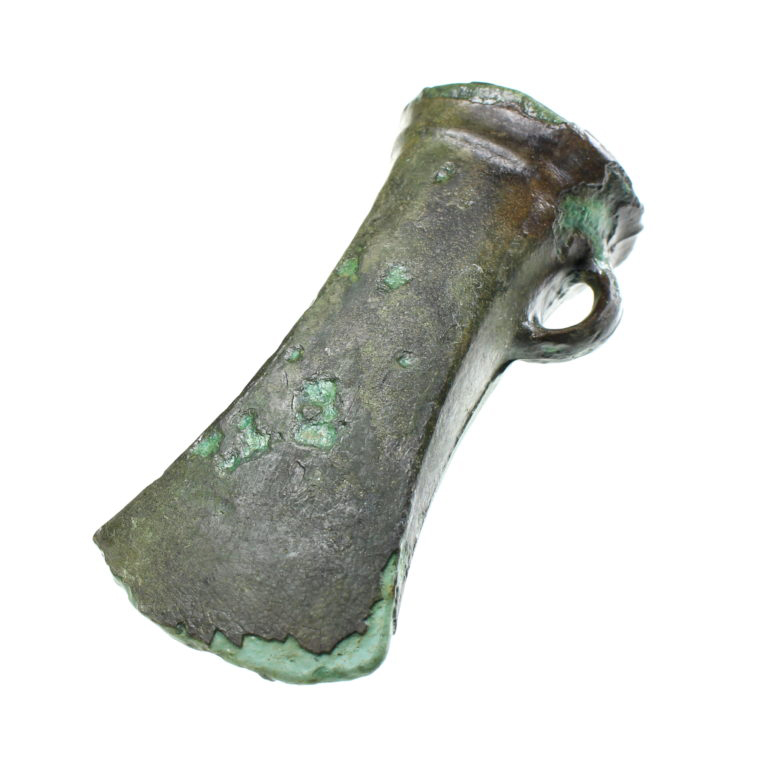
New Stone Age or Neolithic (2600 BC – 4000 BC)
Farming gradually spread northwards from its heartland in the Near East, where it emerged prior to 9,500 BC, eventually reaching Britain’s shores around 4,000 BC. Its arrival marked the start of the New Stone Age or ‘Neolithic’ in Britain. Genetic evidence shows that the spread of farming included the movement of people as well as ideas.
Forests began to be cleared to provide space for crops and livestock. Earthworks also began to be constructed, usually taking the form of ritual monuments, for example burial mounds (long barrows) and henges. An important technological development was the introduction of pottery, which began to be produced for the first time in Britain during this period. While the growing of crops necessitated a somewhat more settled way of life, it is thought that most people in southern Britain remained semi-nomadic, travelling with their animals as they herded them from place to place to find the best pasture. Numerous Neolithic flint tools have been found in Chilmington Green, which suggests that bands of Neolithic people passed through the area.
Image below -Illustration showing the spread of farming and Neolithic technologies to Britain from the Near East.
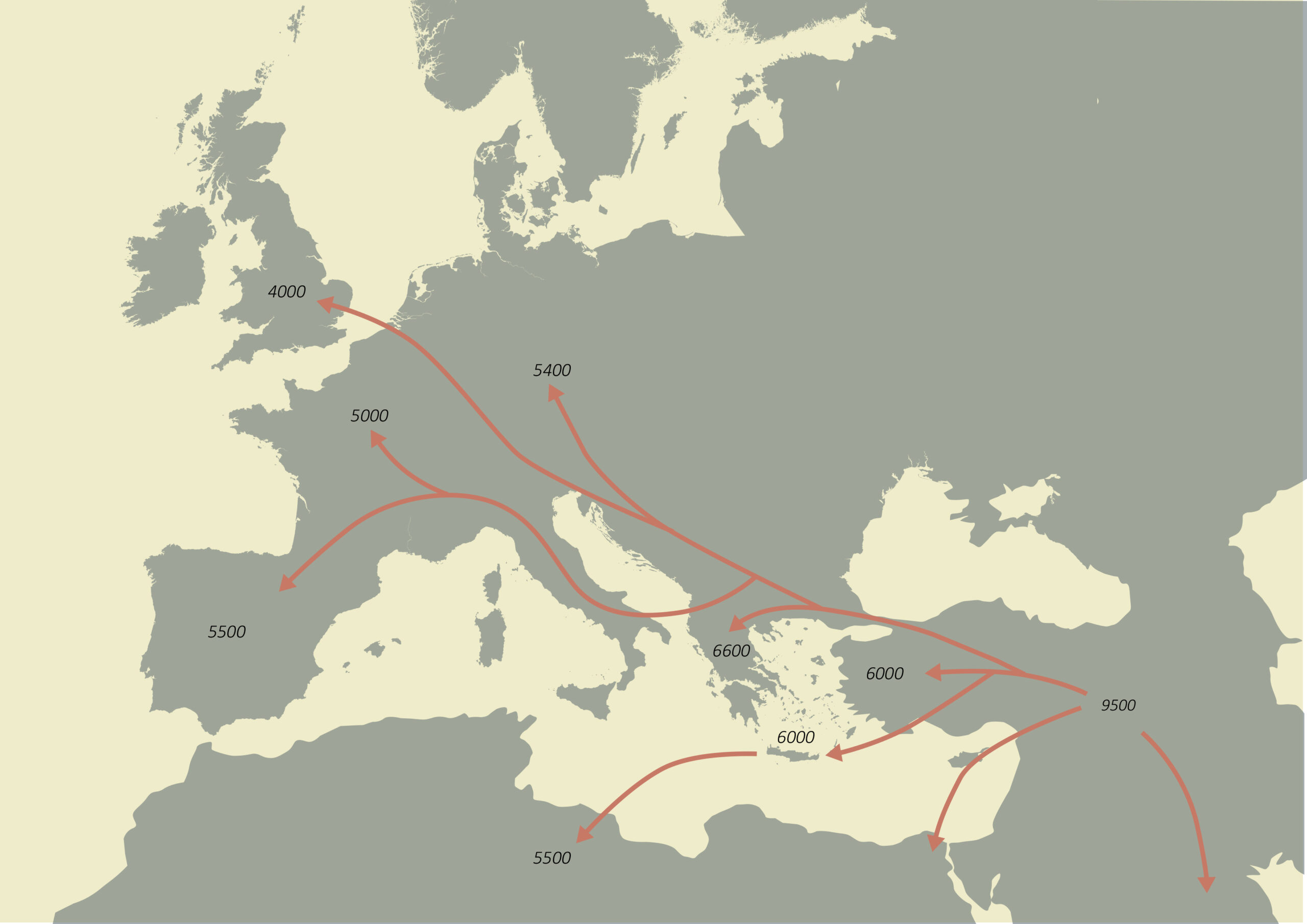
Middle Stone Age or Mesolithic (4000 BC – 10,000 BC)
The end of the last Ice Age around 10,000 BC saw temperatures across Britain rise. This caused environmental change, with grasslands giving way to forests and wetland environments as sea levels gradually rose.
As the environment changed the human inhabitants had to adapt, developing new tools and technologies. Flint scatters dating to this period have been found in and around Chilmington Green, which demonstrates that Mesolithic hunter-gatherers roamed through this landscape. The presence of the River Stour and its once extensive floodplain may have drawn people to the area, as such environments provided a bounty of food and other resources. At Cheeseman’s Green, just 4km to the east of Chilmington Green, a possible Mesolithic settlement and cremation burial have been discovered. This may be the earliest cremation burial yet found in Britain!
Image below – A modern reconstruction of a hunter-gatherer campsite in a wetland habitat.

Old Stone Age or Palaeolithic (10,000 BC – 850,000 BC)
The Old Stone Age, or Palaeolithic, began around 850,000 to 800,000 years ago in Britain, when the first humans arrived. Very little is known about these first occupants, but what we can say for certain is that they were a different species to modern humans, with Homo antecessor being a possible candidate. This long timespan included four warm periods (interglacials), interspersed by longer, cold Ice Ages (glacials). People were only able to live in Britain towards the end of the cold periods and during the warm periods, moving further south when necessary. Fortunately for them, this was easier than it would be today because Britain was connected to the Continent by a land bridge for much of the Palaeolithic, which now lies underneath the North Sea and the English Channel due to sea level rise over time. Neanderthals (Homo neanderthalis) arrived across this land bridge around 400,000 years ago, followed by the first modern humans (Homo sapiens) as late as 40,000 years ago. They were nomadic (roaming) peoples, travelling in small family bands, who made flint tools for hunting and survival.
Palaeolithic flint tools, including ancient hand-axes, have been found near Chilmington Green, mainly recovered from river gravels.
Image below – An example of a Palaeolithic hand axe.

